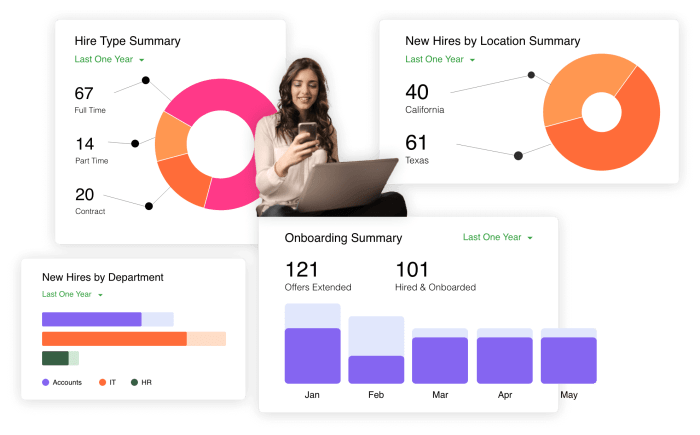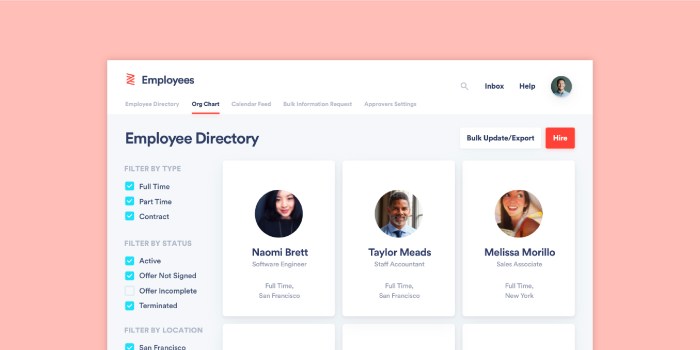Employee onboarding training HR software revolutionizes the way companies integrate new hires. Efficient onboarding is crucial for employee retention and productivity, and the right software can significantly improve the process. This software automates tasks, streamlines communication, and ensures consistent training delivery, leading to faster employee ramp-up and improved overall performance.
From initial paperwork to ongoing training modules, these platforms offer a centralized system for managing all aspects of employee onboarding. Features often include automated workflows, personalized learning paths, compliance tracking, and performance monitoring tools. This allows HR departments to focus on strategic initiatives while ensuring a smooth and effective onboarding experience for each new employee.
The first few weeks of a new employee’s journey significantly impact their long-term success and overall contribution to the company. A robust onboarding process is no longer a luxury but a necessity for businesses of all sizes. This is where employee onboarding training HR software steps in, revolutionizing how organizations welcome and integrate new hires. This detailed guide explores the benefits, features, and considerations when choosing and implementing such software, ensuring a seamless and engaging onboarding experience for your team.
Understanding the Importance of Employee Onboarding Training
Effective onboarding goes far beyond simply handing over a handbook and assigning a desk. It’s a strategic process designed to integrate new employees into the company culture, equip them with the necessary skills and knowledge, and set them up for success from day one. Poor onboarding can lead to higher turnover rates, decreased productivity, and a negative impact on company morale.

Source: exacthire.com
Conversely, a well-structured program fosters engagement, boosts retention, and accelerates the time-to-productivity.
Key Benefits of a Structured Onboarding Program:
- Increased Employee Retention: A positive initial experience significantly increases the likelihood of an employee staying with the company long-term.
- Improved Employee Engagement: Onboarding helps employees feel valued and connected to the company culture, leading to higher engagement levels.
- Faster Time-to-Productivity: Well-trained employees become productive more quickly, contributing to the company’s bottom line.
- Reduced Turnover Costs: Lower turnover rates translate to significant savings on recruitment, training, and lost productivity.
- Stronger Company Culture: Onboarding reinforces company values and helps new hires understand the organizational culture.
Employee Onboarding Training HR Software: Your All-in-One Solution
Employee onboarding training HR software offers a centralized platform to manage and streamline the entire onboarding process. These solutions typically include features designed to automate tasks, track progress, and provide a consistent experience for all new hires. This eliminates the manual effort involved in traditional onboarding methods, freeing up HR professionals to focus on strategic initiatives.
Essential Features of Effective Onboarding Software:, Employee onboarding training hr software
- Automated Workflow Management: Automates tasks such as sending welcome emails, assigning tasks, and tracking progress.
- Centralized Content Repository: Provides a single source of truth for all onboarding materials, ensuring consistency and accessibility.
- Personalized Onboarding Experiences: Allows for tailoring the onboarding experience to specific roles, departments, or even individual employees.
- Compliance and Legal Management: Helps ensure compliance with relevant regulations and legal requirements.
- Interactive Training Modules: Engaging training modules that can include videos, quizzes, and interactive exercises.
- Performance Tracking and Analytics: Provides data-driven insights into the effectiveness of the onboarding program.
- Integration with Other HR Systems: Seamless integration with payroll, benefits administration, and other HR systems.
- Mobile Accessibility: Allows employees to access onboarding materials and complete tasks from any device.
- Communication and Collaboration Tools: Facilitates communication between new hires, managers, and HR professionals.
- Feedback Mechanisms: Provides opportunities for new hires to provide feedback on their onboarding experience.
Choosing the Right Employee Onboarding Training HR Software
Selecting the right software involves careful consideration of your organization’s specific needs and budget. Consider the following factors:
Key Considerations When Selecting Onboarding Software:
- Scalability: Ensure the software can accommodate your current and future needs as your company grows.
- Integration Capabilities: Check for seamless integration with your existing HR systems.
- User-Friendliness: Choose software that is intuitive and easy to use for both HR professionals and new hires.
- Customization Options: Ensure the software allows for customization to meet your specific onboarding requirements.
- Cost and Pricing Model: Evaluate the different pricing models and choose one that fits your budget.
- Customer Support: Select a vendor that provides reliable and responsive customer support.
- Security and Data Privacy: Ensure the software adheres to industry best practices for data security and privacy.
Examples of Employee Onboarding Training HR Software
Several reputable vendors offer robust employee onboarding training HR software solutions. Researching different options and comparing features is crucial before making a decision. Some popular choices include (Note: This is not an exhaustive list, and market offerings constantly evolve):
- BambooHR
- Workday
- SAP SuccessFactors
- Taleo
- Zoho People
It’s recommended to explore the features, pricing, and reviews of each platform before making a selection. Many vendors offer free trials or demos, allowing you to test the software before committing to a purchase.
Measuring the Success of Your Onboarding Program
Regularly assessing the effectiveness of your onboarding program is crucial for continuous improvement. Key metrics to track include:
Key Performance Indicators (KPIs) for Onboarding Success:
- Time-to-Productivity: How long it takes new hires to reach full productivity.
- Employee Retention Rate: The percentage of employees who remain with the company after a specific period.
- Employee Engagement Scores: Measuring employee satisfaction and commitment.
- Onboarding Completion Rates: Tracking the percentage of new hires who complete all onboarding tasks.
- New Hire Feedback: Gathering feedback from new hires on their onboarding experience.
Frequently Asked Questions (FAQs)
- Q: What is the average cost of employee onboarding software? A: The cost varies significantly depending on the features, number of users, and vendor. Expect to pay anywhere from a few hundred dollars per month to several thousand, depending on the scale and complexity of your needs.
- Q: How long does it take to implement employee onboarding software? A: Implementation time depends on the complexity of the software and your organization’s processes. It can range from a few weeks to several months.
- Q: Can I integrate employee onboarding software with my existing HR systems? A: Most reputable software solutions offer integration capabilities with various HR systems. Check for compatibility with your current systems before making a purchase.
- Q: What are the benefits of using employee onboarding software over manual processes? A: Automated processes, improved consistency, reduced administrative burden, enhanced data analysis, and a more engaging experience for new hires are some key benefits.
- Q: How can I ensure my onboarding program is compliant with relevant regulations? A: Choose software that includes features to manage compliance with relevant laws and regulations. Consult with legal counsel to ensure your program meets all requirements.
Conclusion
Investing in employee onboarding training HR software is a strategic decision that can significantly impact your organization’s success. By streamlining the onboarding process, you can improve employee retention, boost productivity, and foster a stronger company culture. Choosing the right software and regularly evaluating its effectiveness will ensure a positive and productive experience for all new hires.
References
(Please insert links to relevant articles and resources from reputable sources like SHRM, HR.com, etc. This section should be populated with actual links for a complete article.)
Call to Action: Employee Onboarding Training Hr Software
Ready to transform your onboarding process and elevate the employee experience? Explore our recommended onboarding software solutions today and request a demo to see how we can help you create a seamless and engaging onboarding journey for your new hires!
In conclusion, investing in employee onboarding training HR software offers substantial returns. By automating tasks, improving communication, and ensuring consistent training, organizations can significantly enhance the employee experience, boost productivity, and ultimately drive business success. The benefits extend beyond immediate cost savings to encompass long-term improvements in employee retention and overall organizational performance. Choosing the right software solution requires careful consideration of specific needs and organizational goals, but the potential rewards are undeniable.
FAQ Summary
What are the key features to look for in employee onboarding HR software?

Source: emptrust.com
Key features include automated workflows, customizable training modules, integrated communication tools, compliance tracking, performance monitoring, and reporting dashboards.

Source: charliehr.com
How much does employee onboarding HR software typically cost?
Pricing varies greatly depending on the features, number of users, and vendor. Expect to see options ranging from affordable monthly subscriptions to more comprehensive enterprise solutions with higher price tags.
How can I ensure employee engagement with the onboarding software?
Gamification, interactive modules, personalized learning paths, and regular feedback mechanisms can all help improve employee engagement and participation.
What are the common integration challenges with existing HR systems?
Integration challenges can arise with legacy systems or those lacking robust APIs. Careful planning and potentially professional services are often needed to ensure seamless data flow.